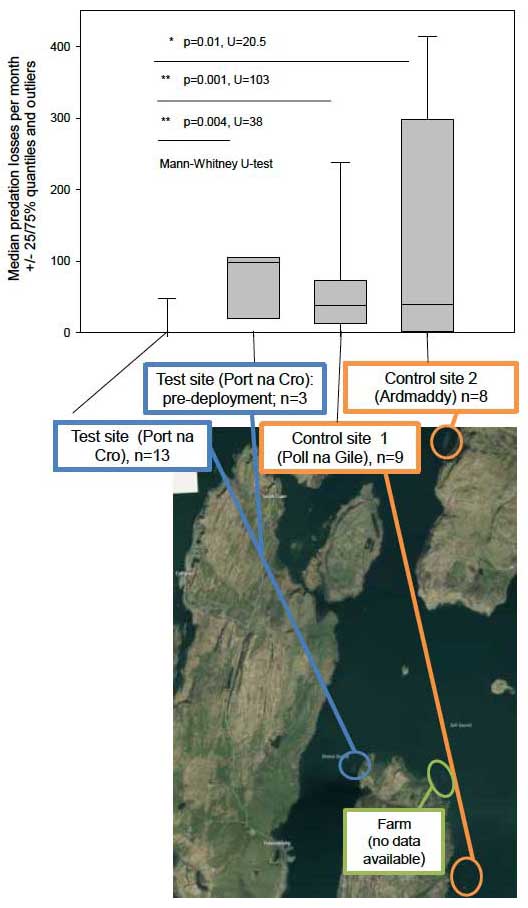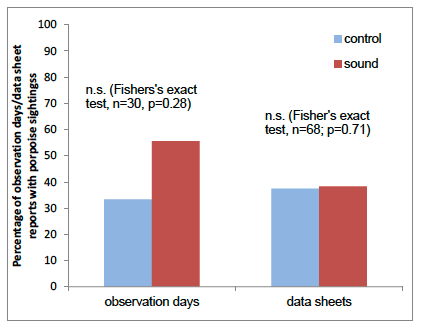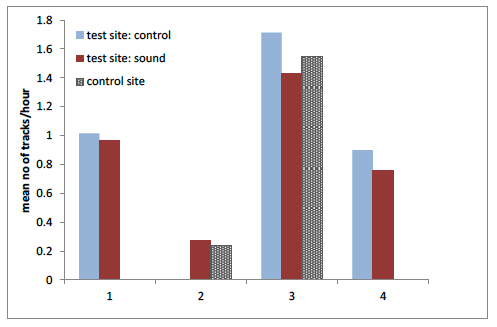Acoustic deterrence using startle sounds: long term effectiveness and effects on odontocetes
This report presents the findings of field experiments aimed as testing the long-term effectiveness of a new deterrence method (acoustic startle reflex)on pinnipeds.
Long-term test on a fish farm in Argyll
Methods
A long-term field experiment was carried out on fish farms operated by Meridian salmon (Ltd.), formerly known as Lakeland Marine. A fish farm on the northwest tip of Shuna Island was chosen as the test site (Port na Cro). Two additional farms in close spatial proximity (operated by the same company) were designated as control sites (Poll na Gile & Ardmaddy). None of the farms in the area had previously operated ADDs. A questionnaire scheme was introduced which asked farm workers to 1) provide the number of fish lost due to seal predation, 2) overall losses for each stocked cage, and 3) additional information, including whether porpoise or schools of wild fish were seen around the farm. A sample questionnaire is provided in appendix 2.
The test site, Port na Cro, and one of the control sites, Poll na Gile, were stocked in October 2010 and harvested in February/March 2012. The second control site, Ardmaddy, was on a different production cycle and contained large fish before harvesting in April-May 2011. It was then fallow and re-stocked with medium sized fish at the beginning of August 2011.
Monitoring of predation started in November 2010 and was initially carried out in the form of site visits. This involved scientists carrying out detailed mort counts and comparing data with the records in the farms' logbook and dive reports. Data sheets were fully established at the test site by the middle of December 2010 and are still being filled in. Mort counts either involved sorting through fish retrieved by divers or fish removed from baskets at the bottom of the net (except for Ardmaddy where no baskets are installed). Staff members occasionally failed to fill in the questionnaire on the control sites, therefore predation data was collected using a combination of sources including questionnaires, dive reports, basket counts reported in the farms logbook and basket counts carried out directly by scientists. Predation data was collected for 16 months on the test site (3 month pre-deployment and 13 month sound exposure), 9 months on control site 1 (Poll na Gile) and 8 months on control site 2 (Ardmaddy). The startle system was first installed on 16 January 2011 with two transducers and upgraded to four transducers on 7 February 2011. The equipment was removed on 1 February 2012. A record of loudspeaker operation and setup changes is given in appendix 1.
In addition to the predation monitoring scheme visual observations of marine mammals were carried out around the fish farm. A theodolite tracking method was used to determine surface positions of seals, porpoise and otters in the vicinity of the fish farm. Observations were carried out from the roof of a food barge in conditions of sea state 2 or less. Observers were either scanning by eye or with 10x50 binoculars. If the observer detected an animal he/she tried to locate it with the theodolite and, if successful, started logging consecutive surface positions (called a track). Animals were tracked until no resurfacing occurred within 15 minutes after the last surfacing had been logged. Observations were carried out on 18 days during sound exposure and 12 control observation days. The latter were primarily during the pre-deployment phase but in some cases also during the operational phase when the equipment was temporarily switched off. The overall observation effort was 76 hours 15 minutes during sound exposure, 25 hours 20 minutes during the pre-deployment/control periods and 19 hours 45 minutes on control site 1 (Poll na Gile).
The source level of the acoustic deterrent system was measured in a series of trials from a pontoon in Craobh Haven Marina. Measurements were carried out using a B&K 8103 hydrophone and a B&K 2635 charge amplifier connected to a M-audio Microtrack II recorder. The measured source levels were between 176 and 179 dB re 1µPa. Playback signals consisted of 200ms long, 2 octave-band noise pulses with an onset time of 5 ms played at a duty cycle of between 0.8 and 1%.
Fig 3: Average predation losses per week (calculated for 1 month periods) on the test and control sites. There was a highly significant reduction in predation on the test site during sound exposure compared to the predeployment period and control sites (Mann-Whitney U tests).

Statistical data analysis was carried out in PASW Statistics 19. Direct comparisons between the control and test sites, and between sound exposure and pre-deployment periods were conducted based on the overall counts of lost fish per month (adding up all dead basket counts and dive reports). These comparisons were done on the untransformed data using non-parametric statistics (Mann-Whitney U tests). In one case, data were only available for part of the month (Ardmaddy, May 2011) and in another case, a month was split between two treatments (January 2011, sound versus pre-deployment period); with data scaled up to reflect a one month period. In addition to the comparison on the direct counts, a predation model was calculated taking month (January-December), site (Port na Cro, Poll na Gile, Ardmaddy), sound exposure (yes or no) and the interaction between month and site into account. Data were transformed using a Box-Cox transformation prior to modelling to yield normality.
Results
Predation loss
The overall number of fish losses per month was compared between the pre-deployment and the sound exposure phase at each site (Fig 3). There was a highly significant reduction in the number of fish losses at the test site when the startle system was operating compared to the pre-deployment period (Mann-Whitney U, n=16, U=38, p=0.004, Fig 3). In fact, median losses per month were zero on the test site when the equipment was operating. This was a highly significant difference in predation losses compared to the control sites (Poll na Gile, Mann-Whitney U, n=22, U=103, p=0.001; Ardmaddy, n=21, U=20.5, p=0.01). Median losses were 41 fish/month on control site 1 (Poll na Gile), 39 fish/month on control site 2 (Ardmaddy), 98 fish/month on the test site before the deployment of the deterrent system and zero fish per month when the equipment was operating (Fig 3). There were only 5 consecutive events of negligible to moderate predation on the test site within the whole 13 month sound exposure period, which consisted of 58, 14, 7, 5 and 1 lost fish.
Table 1: General Linear Model ( GLM) calculated to predict the influence of various factors on seals seal predation.
| GLM | df | F | P |
|---|---|---|---|
| Corrected Model | 29 | 11.97 | .032 |
| Intercept | 1 | 643.9 | .000 |
| sound exposure | 1 | 59.1 | .005 |
| month | 12 | 12.2 | .031 |
| site | 2 | 3.61 | .159 |
| month * site | 14 | 4.68 | .115 |
A general linear model was calculated to detect trends and factors influencing predation losses across all three sites. The predation model included predation losses (average fish per week for each month) as dependant variable and 'month', 'site', 'sound exposure' and the interaction term 'month*site' as independent factors. The model was significant and explained 91% of the variance in the data set (see table 1). The factor that had by far the strongest influence on predation losses was 'sound exposure' (F 29,1 =59, p<0.005). Seal predation was also influenced by the time of the year (factor 'month') but to a much lesser extent than sound exposure (F 29,12=12.2, p=0.031). In contrast, 'site' and the interaction between 'month and site' did not have a significant influence on predation. Therefore, the model showed that while predation varied across different times of the year the most important factor influencing predation was operation of the acoustic startle system.
Seal predation accounted for a comparatively small amount of the overall losses on most farms. At the test site, a monthly average of 7% of the overall losses were caused by seals during the pre-deployment period. This value dropped to a monthly average of 0.5% during sound exposure. The average percentage of predation losses on the control sites was 7% (Poll na Gile) and 18% (Ardmaddy) respectively. The highest percentage of seal-inflicted losses was found in Ardmaddy in May 2011 with 80% of the overall losses caused by seals predation. The high number of losses unrelated to seals were partly due to natural 'die-offs' but had primarily to do with the fact that the test site was infected by Pancreas disease ( PD) during the early stages of the production cycle. In the later stages of the production cycle, all sites were significantly affected by sea lice and parasitic amoeba.
Abundance and movement of marine mammals around the test and control sites
Surface positions of marine mammals were logged using a theodolite tracking method with an observer positioned on the food barge of the test site. The most commonly observed species around the farm were common seals (Phoca vitulina) and harbour porpoise (Phocoena phocoena). Single grey seals (Halichoerus grypus) were observed passing through the area on two separate control observation days and otters (Lutra lutra) were seen in the vicinity of the farm on four sound exposure and two control observation days. Seals were sighted on all 12 control observation days and on 14 out of 18 sound exposure days. Porpoise sightings were similarly frequent with animals being spotted on 6 out of 12 control observation days and 11 out 18 sound exposure days. The overall distribution of all surface positions for these species is shown on the maps in figure 4. Porpoise sightings were distributed over a wide area but many sightings occurred within a few hundred meters of the fish farm. It is important to note that observation effort was highly unbalanced between sound exposure and control observation periods and the much higher number of logged surface positions during sound exposure is due to the higher observation effort. The number of seal tracks per hour was therefore calculated for each observation day and the mean values of all observation days were compared between sound exposure and control observation periods (Fig 5) at distances of 0-25m, 25-100m and more than 100m from the nearest loudspeaker. The 25m distance cut-off was chosen based on previously measured deterrence ranges using the same deterrence method. However, no significant differences in the mean number of seal tracks per hour were found in any of the distance bins (t-tests; 25m: t=0.73, p=0.47; 25-100m: t=1.5, p=0.885; >100m: t=0.83, p=0.413). The mean number of seal tracks was slightly lower in the closest distance class (<25m) but this difference was not significant. Similarly, there were no changes in the mean number of porpoise tracks per hour as the result of sound exposure at any of the distance classes (Fig 5, t-tests; <25m: t=0.75, p=0.94; 25-100m: t=0.459, p=0.65; >100m: t=-0.112, p=0.912). Additional response variables showed that the overall porpoise abundance throughout the year was not affected by the deterrence equipment. The percentage of observation days on which porpoise were seen within 100m of an operating underwater loudspeaker (Fig 6) was in fact slightly higher during sound exposure (56%) compared to control observation days (38%), although this difference was not significant (Fisher's exact test n=30, p=0.28). As an additional measure for porpoise abundance around the farm, we counted the number of questionnaires which reported opportunistic sightings of porpoise groups. While these reports may not be as reliable as dedicated observations by scientists, farm staff spent much more time on the farm. Farm staff reported sightings of porpoise groups on 33% of the data sheets during control observation periods and 38% during sound exposure. Again, this difference was not significant which indicates that year round presence of porpoise was not influenced by the operation of the experimental acoustic startle system (Fisher's exact, n=68, p=0.71).
The high number of seal surfacings close to the cages raised questions about what factors influence seal distribution around fish farms throughout the year. Figure 6 shows the mean number of seal track/hour calculated over 3 month periods (quarters). A large number of tracks were logged within the 3 rd quarter (July-September) for both the test (Port na Cro) and control site (Poll na Gile) where on average 1.5 and 1.7 seal track per hour were logged during that time. Many of the seals observed in July to September were new-born pups. There were several common seal pupping sites within a few miles of the fish farms and the large number of pup sightings around the farms coincided with their weaning period.
Fig 4: Distribution of seal (upper panels) and porpoise (lower panels) sightings around the fish farm during control observation days (left column) and sound exposure days (right columns). The large blue rectangle marks the area covered by the fish farm while the small blue rectangle depicts the feed barge where the visual observer was positioned.

Fig 5: Mean number of seal a) and porpoise tracks b) per hour per day for the three distance bins (distance to the closest loudspeaker).

While the known presence of porpoise and seals in the area was a reason for choosing the study site, sightings of otters were unexpected and originally not intended to be part of the study. However, we logged otter sightings systematically (Fig 7). Most otter tracks occurred along the shoreline southeast of the farm. Otters were sighted on 4 sound exposure days (4 tracks) and 2 control observation days (2 tracks). The closest observed approach distance during sound exposure was 50m and 15m during control observation days.
Fig 6: Percentage of observation days on which porpoise where seen within 100m of a loudspeaker (left block) during sound exposure (red) and control observation days (light blue). The block on the right shows the percentage of questionnaires (data sheets) which reported porpoise sightings around the farm.

Fig 7: Mean number of tracks per hour calculated for the 4 quarters of the year for the test site during sound exposure, the test site prior to deployment and the control site 1 (1: Jan-Mar, 2: Apr-June, 3: Jul-Sep, 4: Oct-Dec). Missing columns indicate that no data was collected for the respective quarter.

Contact
There is a problem
Thanks for your feedback